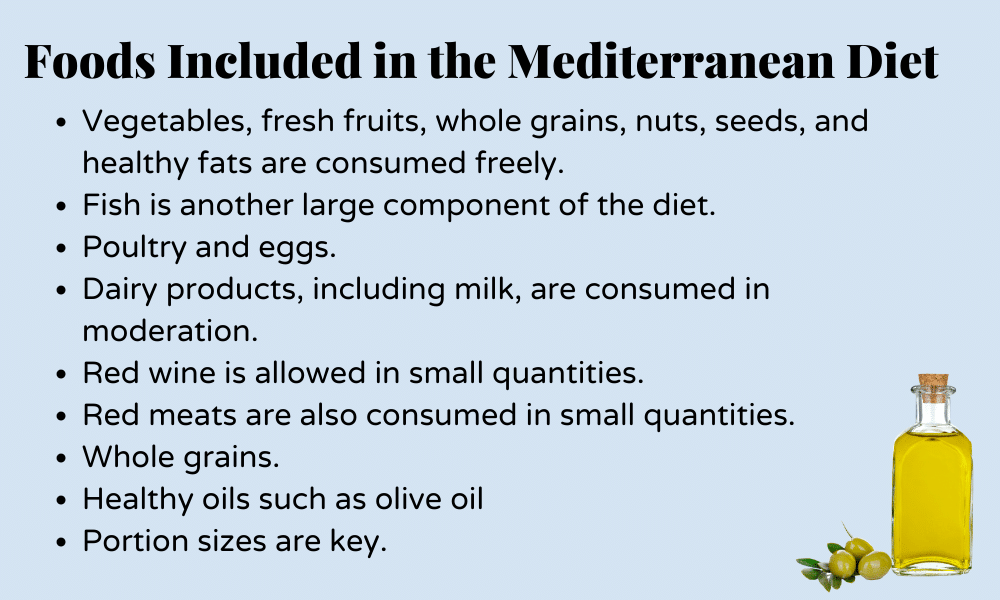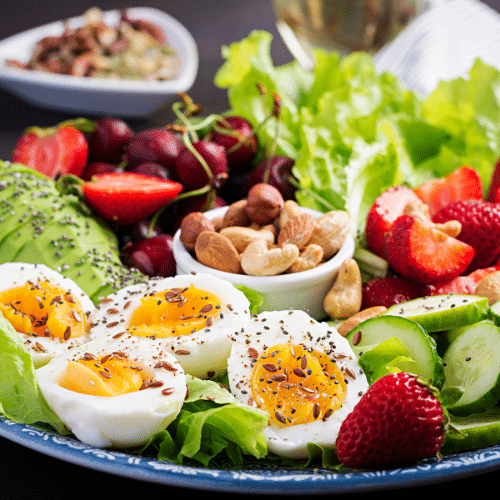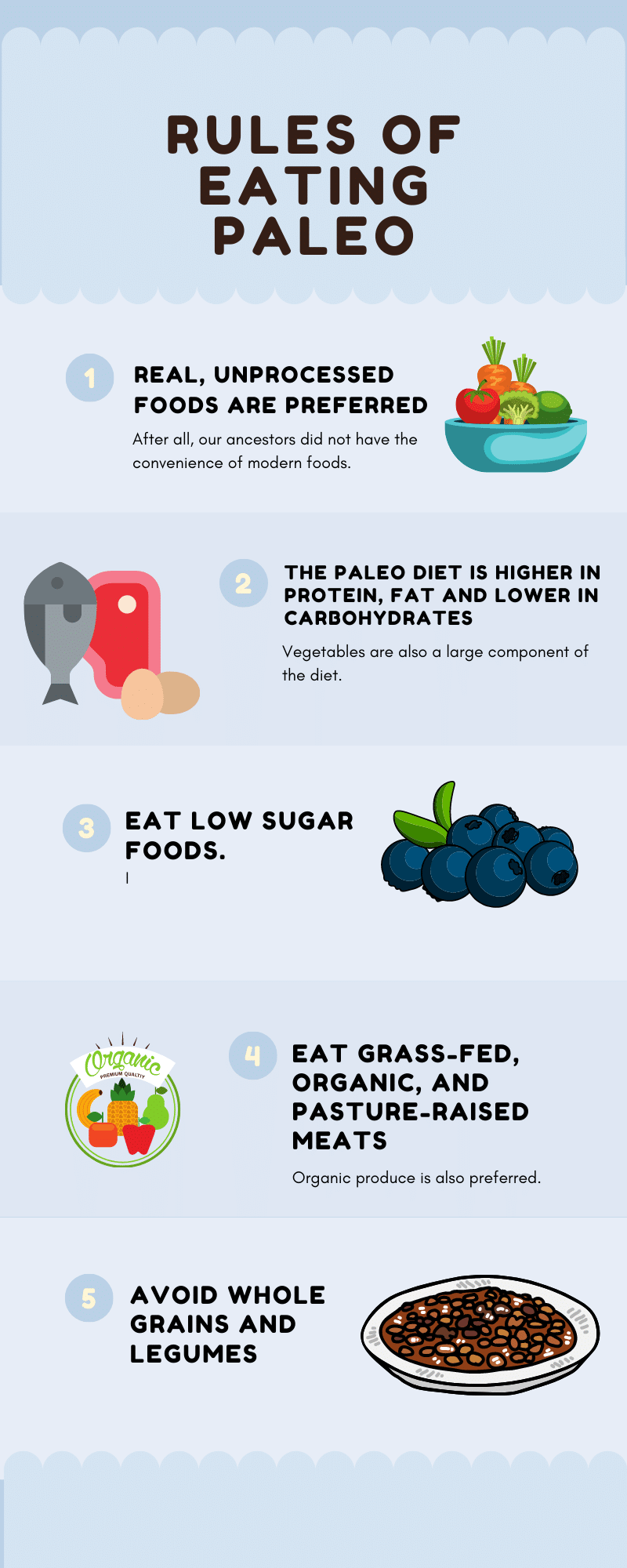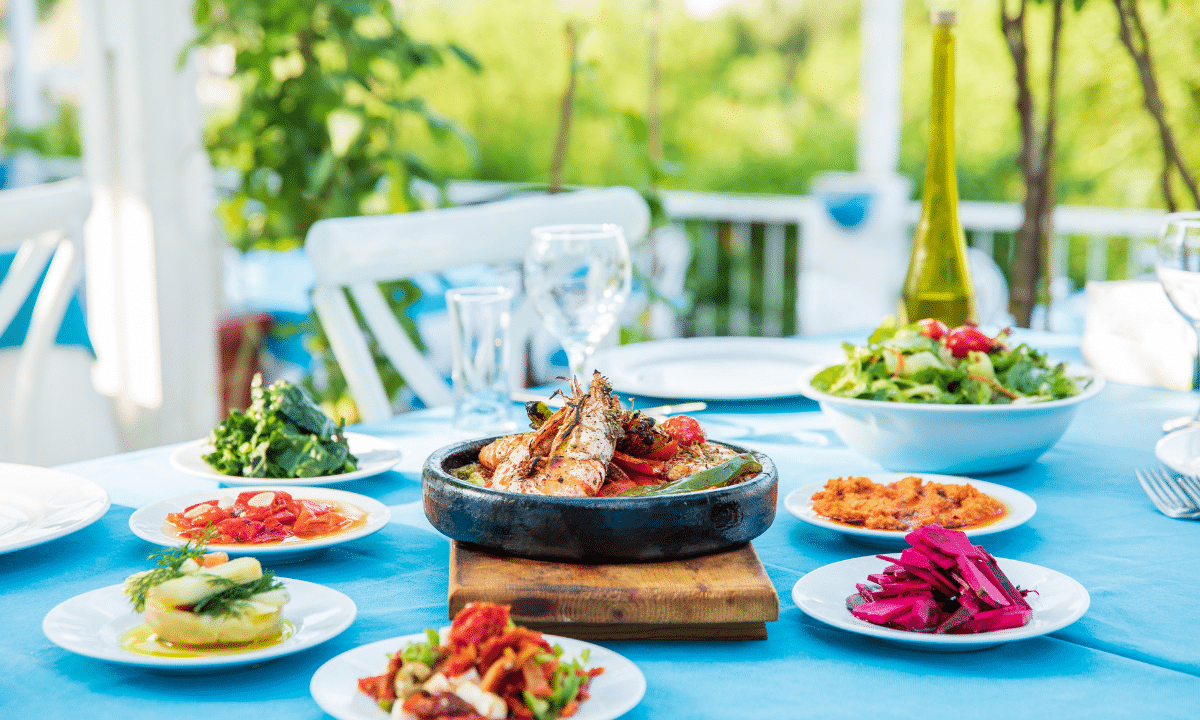Paleo vs Mediterranean Diet: Which One Is Best For You
When it comes to food, one size does not fit all. Lifestyle, taste preferences, health, and how you feel about a specific eating pattern all matter and will have an impact on how successful you are with a particular plan.
Table of Contents
ToggleIn this blog we will help you make a decision about what eating style is best for you by comparing two popular plans: the Paleo and the Mediterranean diet, and we’ll explore a combination of both: the Paleo-Mediterranean diet.
The Mediterranean diet is one of the most popular structured eating plans. The great of the benefits of the eating pattern followed by people who live in the Mediterranean area is the variety of foods they can enjoy.
The Paleo diet is a more restrictive, low-carbohydrate plan with clear rules. However, the macronutrients are better balanced than in other low-carbohydrate diets such as keto.
Both types emphasize eating whole foods and discourage the consumption of modern processed foods.
The question is: which is the best one for you?
What is the Mediterranean Diet?

The Mediterranean eating pattern is a diet of abundance that emphasizes the enjoyment of meals.
Foods included in the Mediterranean diet include olive oil, nuts, legumes, fruits, vegetables, whole grains, dairy, fresh fish, and small quantities of lean meats and wine. Processed foods are discouraged.
It also encourages you to enjoy your meals in the company of friends or family.
The Mediterranean type of plan originated from observing the benefits of the eating style of the people living in the Mediterranean region, including Spain, Southern France, Italy, Albania, Greece, Turkey, and Morocco.
The benefits of the Mediterranean approach for health are remarkable and include promoting heart health, cognition, gut health, weight management, and protection against diabetes, arthritis, depression, and anxiety. (1)
Most experts consider this way of eating to be safe, sustainable, effective and one of the best approaches for overall health.
What Foods Can You Eat in the Mediterranean Diet?

What Foods Do You Need to Avoid in the Mediterranean Diet?
- Processed foods
- Large amounts of sugar
- Sweetened beverages such as sodas and energy drinks
Alcohol in the Mediterranean Diet

Researchers believe that moderate drinking contributes to the lower rates of heart disease found among the people living in the Mediterranean. (2)
However, it’s important to keep in mind that drinking too much can increase the risk of certain cancers, liver disease, digestive issues, and heart disease, (3) as well as increasing the risk of accidents.
Moderate drinking is considered to be one glass of alcohol per day for women and two for men.
Typical Meals in Mediterranean Countries
Breakfast
- Small caffè latte, croissant, jam, and fresh fruit – Italy
- Eggs, cheese, olives, fresh tomatoes and cucumbers, bread, fruit, and coffee – Turkey
- Toast with ham, tomatoes, olive oil, and coffee – Spain
Lunch
- Gjellȅ, a dish consisting of slowly cooked meat with vegetables and olive oil; served with tomato, cucumber, bell pepper, and olive oil – Albania
- Salad, vegetable and meat stew, and couscous – Morocco
- Quiche served with salad – France
Dinner
- Tomato, cucumbers, greens, feta cheese and olive oil salad – Greece
- Beef shish kebabs served with couscous and vegetables – Turkey
- Greek-style baked fish served with potatoes – Greece
The secret ingredient
Enjoyment of your meals is the secret ingredient to the success of this plan; there is something powerful about eating foods that taste great and are good for you.
The Paleo Diet
What is the Paleo Diet?

The Paleolithic diet is sometimes referred to as the caveman or paleo diet because it focuses on eating foods that early humans ate in the Paleolithic era, including all foods available before the development of farming. It eliminates all modern-day processed foods.
As a result, Paleo dieters must remove grains, beans, and legumes; and include meat and fish, mimicking the diet of people in the hunter-gatherer era.
Paleo followers usually view it as more than just a pattern of eating. It’s normally seen as a way to improve lifestyle practices, saving the environment and overall well-being.
In addition, there are high standards for the quality of foods you select on the paleo approach. For example, protein should be grass-fed and ingredients are preferably organic.
Compared to other diets, research shows that the paleo can result in more weight loss, improved glucose tolerance, better blood pressure control, lower triglycerides, and better appetite management. (2)
Paleo is thought by many to be closer to the natural way of eating. The Mayo Clinic suggests that there is a mismatch between the human body’s genetics and the modern diet, which has created obesity and chronic diseases. This imbalance is believed to be related to a sudden change in eating practices, outpacing the body’s ability to adapt. (2)
Rules for Eating Paleo Diet

What Foods Can You Eat in the Paleo Diet?
- Lean protein such as chicken, turkey, pork, beef, veal, bison, and eggs
- Healthy fats such as olive oil, and avocado
- Fish such as those rich in omega 3 fatty acids, like salmon and trout
- Seafood
- Fats such as olive oil, avocado oil, coconut oil, grass-fed butter, and ghee
- Nuts such as almonds, cashews, hazelnuts, pecans, macadamia nuts, and walnuts.
- Seeds such as sunflower seeds, sesame seeds, chia seeds, flax seeds, and pumpkin seeds
- All non-starchy vegetables such as asparagus, artichoke hearts, brussels sprouts, spinach, celery, broccoli, cauliflower, zucchini, cabbage, peppers, eggplant, onions
- Carrots, squash, yam, and sweet potatoes
- Fresh fruits lower in sugar such as apples, berries, apples, watermelon, and cantaloupe
What Foods Do You Need to Avoid in the Paleo Diet?
- Grains, including rice, wheat, oats, and barley
- Bread, English muffins, crackers
- Pasta
- Legumes, including beans, lentils, garbanzo, peanut butter, and soybeans
- Dairy products, including milk, cheese, dairy spreads, cream cheese, pudding, ice cream, and yogurt
- Sugar
- Starchy vegetables such as potatoes, sweet potatoes, carrots, yucca, and malanga
- Processed foods
- Fruit juices and sugary beverages
- Processed meats such as hot dogs, sausages, deli and low-quality
Alcohol in the Paleo Diet
Alcohol was not consumed by our ancestors and it’s processed as a toxin. Therefore avoiding alcoholic beverages is ideal within paleo.
However, to make a sustainable change, flexibility is common with most diets, and some paleo followers approve of an occasional glass of wine or lower carbohydrate alcoholic drinks like tequila and hard ciders.

Typical Meals in Paleo Diet
Breakfast
- Green smoothie made with cucumber, spinach, avocado, and apple
- Eggs, avocado, and coffe with almond milk
Lunch
- Chicken lettuce wraps
- Arugula, tomato, and cucumber salad with salmon and olive oil
Dinner
- Grass-fed sirloin strips and roasted vegetables with olive oil
- Chicken stir-fry with broccoli and peppers; mushroom soup
Paleo vs Mediterranean Diet
Both the paleo and the Mediterranean diets have health benefits, but as you have seen, they are very different ways of eating. Here we break it down to illustrate how they are the same and how they are different so that you can easily see which one is likely to be the best choice for you.
| Similarities | Differences |
| Both encourage eating whole foods | The Mediterranean plan is a diet of inclusion and most foods are an acceptable part of this eating pattern |
| Both discourage eating processed foods | The paleo is more restrictive and eliminates major food groups, including legumes, dairy products, and grains |
| Both include protein, fish, vegetables, fruits, nuts, and seeds | The paleo is lower in carbohydrates |
Which is Easier to Follow, Paleo or Mediterranean?
Considering the level of restrictions in the paleo plan, the Mediterranean diet is easier to follow. The key to the success of the Mediterranean style is that you can follow it for long periods of time and thereby obtain all the benefits.
Health Benefits
Weight Loss
In the short term, paleo can result in faster weight loss as it’s more restrictive than the Mediterranean diet.
Also, diets higher in protein and lower in carbohydrates – like the Paleo diet – can result in faster weight loss and a spontaneous decrease in food intake. (3) In the long term, the Mediterranean eating plan can be easier to sustain as it’s more of a lifestyle so maintaining weight loss is easier. (4) The long-term results of the paleo diet are not yet clear.
Paleo vs Mediterranean: Heart Health

Extensive research has been conducted regarding the Mediterranean diet in relation to cardiovascular disease. As a result, it’s clear that this eating style promotes a good heart.
Some of the most important research linking Mediterranea-style eating diet and heart disease comes from the Harvard School of Public Health by researcher Dr. Walter Willet.
His research found clear evidence that elements in the Mediterranean diet are linked to a decrease in heart disease and premature death among Americans. (5)
More surprising outcomes come from research highlighting the effectiveness of the Mediterranean diet. The “Prevención with Dieta Mediterranea” is a study of 7,500 Spanish people in Spain and compared the Mediterranean diet with a low-fat diet.
As background, it’s interesting to note that a low-fat diet is the standard recommended eating pattern in the United States to treat heart disease.
The results were so overwhelmingly positive that the trial was stopped early; after an independent board reviewing the study determined that there have been fewer heart attacks, strokes, and deaths from heart disease in the Mediterranean groups when compared to the low-fat groups. (6)
The elements protecting heart health, including nutrients present in olive oil, nuts, seeds, vegetables, and fruits, are also found in the paleo diet. Thus, it’s possible that the paleo diet is also effective in decreasing the risk of cardiovascular disease.
However, the paleo diet does not include legumes, and it’s harder to maintain eating this way for longer periods of time.
Paleo vs Mediterranean: Blood Pressure
The components of the Mediterranean eating style, such as whole grains, vegetables, fruits, nuts, and extra virgin olive oil, have been shown to lower blood pressure in normotensive and hypertensive patients. (7)
On the other hand, the foods excluded from this diet – red meat and processed meat – have unfavorable effects on hypertension. (8)
The Mediterranean plan is safe and easy to follow, so it’s no surprise that health professionals often recommend it.
In contrast, the paleo diet has no conclusive evidence of beneficial effects on blood pressure and can be more difficult to follow in the long term.
Paleo vs Mediterranean: Blood Sugar Levels
Studies into the effectiveness of a Mediterranean eating style have also shown beneficial effects on diabetes mellitus and glucose metabolism in general.
For example, in a large study of 380 university graduates, a traditional Mediterranean eating pattern was associated with an 83% reduction in developing type 2 diabetes. (9)
A different study of diabetic patients suggested that those following the traditional Mediterranean diet had lower blood glucose two hours after a meal and lower HbA1c, a test that measures average blood sugar over a three-month period. (10)
Researchers believe that the Mediterranean diet is effective due to the high consumption of vegetables, fruits, legumes, nuts, fish, whole grains, and olive oil as well as the moderate consumption of alcoholic beverages and decreased consumption of processed foods and added sugar. (11)
When both the paleo and Mediterranean diets were compared, a study showed that the caveman type of eating was associated with marked improvements in glucose tolerance while participants following the Mediterranean plan showed no significant improvement in their glucose tolerance. (12)
However, the results of the study have not been replicated enough times to determine categorically that the paleo diet is more effective than the Mediterranean to lower blood sugar levels. (13)
The paleo pattern is a low-carbohydrate diet, so it could potentially improve glucose tolerance, decrease insulin secretion, and increase insulin sensitivity.
It is essential to know that a low-carbohydrate diet can lead to a dangerously low blood sugar level for those on blood sugar lowering medications. So, if you’re taking blood sugar medication, it’s important that you speak to your physician to adjust your medication, if necessary.
Paleo vs Mediterranean: Cognitive Health
Interesting research in recent years suggests that the Mediterranean way of eating can protect brain health. Specifically, it can slow down the cognitive decline that results in dementia.
However, it’s not the Mediterranean diet by itself, but rather the combination of the Mediterranean the DASH diet (the MIND diet) that has gained more respect in terms of protecting the brain against rapid cognitive decline. (14)
It has been suggested that a paleolithic type of eating could also potentially be beneficial for cognitive health. (15) However, there have not been many scientific studies corroborating this theory.
One of the studies available revealed that post-menopausal women following the paleo diet had a significant improvement in episodic memory performance, which was associated with increased hippocampal activity, smaller waist circumference, and reduced fatty acids. (16)
In conclusion, more evidence promotes the effectiveness of the Mediterranean diet for cognitive health. However, the plan works best when it’s combined with the DASH diet approach to creating the MIND diet.
Paleo vs Mediterranean: Mental Health

The Mediterranean diet appears to protect mental health. For example, current research studies link the Mediterranean eating style to a reduced risk of depression. (17)
Considering the fact that those following the Mediterranean diet eat a variety of nutrients, it’s possible that they’re less likely to be deficient in the nutrients linked to depression, such as vitamin K.
Similar mental-health-boosting components are also present in the paleolithic – or caveman – diet. The difference is that this type of eating restricts entire food groups, so nutritional deficiencies linked to depression are possible.
There is some evidence that the paleo diet can contribute to blood sugar control and insulin dysfunction.
As a result, paleo dieters could lower the risk of severe depression, as it’s been suggested that people who are insulin resistant are more likely to suffer from severe depression. (18)
Paleo vs Mediterranean: Comparative Required Effort
The Mediterranean plan is a diet of inclusion where most foods fit, so one of it’s biggest benefits is that people can follow it easily and for a long period.
The paleo diet is much more restrictive, therefore more difficult to follow.
Paleo vs Mediterranean Diet: Costs
The Mediterranean diet is the clear winner in terms of food costs. It includes a variety of lower-cost foods such as beans, lentils, and garbanzo beans, and lower amounts of higher-cost foods such as grass-fed animal proteins. Therefore, the Mediterranean diet is significantly lower in cost.
Paleo vs Mediterranean Diet: Health Risks
Most health professionals agree that the Mediterranean diet is a safe and effective eating style because it includes all food groups, so nutrition deficiencies are less likely to occur.
The paleo diet could be less safe because it excludes entire food groups that provide essential minerals and vitamins, potentially leading to a wide variety of diseases.
Additionally, excessive protein intake might be hard to process by the kidneys and can increase the risk of heart disease and certain types of cancer.
The Paleo-Mediterranean Diet
A combination of both diets has emerged in recent years, known as the Paleo-Mediterranean diet.
The Paleo-Mediterranean plan is focused on eating whole foods and excluding processed foods. It’s more inclusive than the paleo diet but doesn’t include all foods as the Mediterranean does. High-quality foods are encouraged.The following explanation of the Paleo-Mediterranean diet comes from Dr. Alex Vazquez, a functional medicine chiropractor.
What Foods Can You Eat in the Paleo-Mediterranean Diet?
| Vegetables | Choose 5-9 servings per day from a wide variety of fresh, in-season, or frozen vegetables |
| Fruits | Choose 2-3 servings per day from a wide variety of fruits – fresh, frozen, or lower-sugar dried fruits like apples, melons, kiwi, plums, pears, pineapple, mango, dates, raisins, and cranberries |
| Protein | 2-3 small servings per day (~3 ounces) of lean protein. Include fish twice a week and include legumes as sources of protein |
| Soy products | Tofu, soy milk, and other soy products are included but are limited to one serving per day |
| Legumes | Include one serving of lentils, black-eyed peas, or any type of beans |
| Seeds | Sunflower, pumpkin, sesame butter (tahini), and others |
| Nuts | Including walnuts, macadamia, Brazils, filberts, pecans, cashews, almonds, also almond milk |
| Berries | All berries, including blueberries, raspberries, blackberries, and currants |
| Dairy | Yogurt with abundant live cultures like Greek yogurt, Activia and kefir, or cultured soy or coconut milk |
| Fats | Healthy fats including olive, canola, and coconut |
| Sweeteners | Includes honey, agave nectar, stevia |
| Beverages | 64 ounces of clean filtered water daily, teas, (including 1 serving of green tea) and organic coffee in moderation |
| Wine | 4 ounces- optional |
What Foods Do You Need to Limit or Avoid in the Paleo-Mediterranean Diet?
| Vegetables | Limit root vegetables such as yams and severely limit other starchy vegetables like corn and white potatoes; avoid canned vegetables |
| Fruits | Limit sweeter dried fruits such as dates, raisins, prunes, grapes, and bananas |
| Protein | Limit red meat intake to once per week, and eggs to 4 per week |
| Dairy | Exclude milk, butter, ice cream, and sour cream; and strictly limit cheese |
| Grains | Severely limit all grains |
| Fats | Limit or avoid seed oils like sunflower, corn, and safflower, lard, all trans fats, (shortening, margarine, deep fryer oils), peanut, and brominated vegetable oils (in preservatives) |
| Sweeteners | Sugar, aspartame, NutraSweet, Splenda, saccharin, acesulfame-K |
| Beverages | Exclude all types of soda, fruit juices, Kool-aid, artificially flavored and bottled drinks, imitation juice, caffeinated energy drinks, all distilled alcohol and beer, and malt alcohol beverages |
| Other foods | Exclude ALL commercially-made foods, frozen meals, fast foods, convenience foods, artificial foods, chemical food additives, artificial flavorings, and all artificial sweeteners |
I

Dr. Su-Nui Escobar, a Registered Dietitian/Nutritionist in Miami, FL, is dedicated to empowering women in perimenopause and menopause to live healthier, more satisfying lives.
With a doctorate in clinical nutrition from the University of North Florida, she has expertise in menopause and weight loss, including the unique challenges faced by those on weight loss medications.
Su-Nui’s passion for her field is evident in her previous role as the Academy of Nutrition and Dietetics spokesperson.


